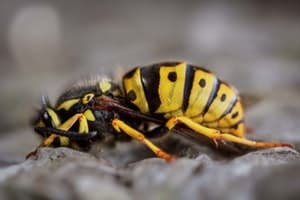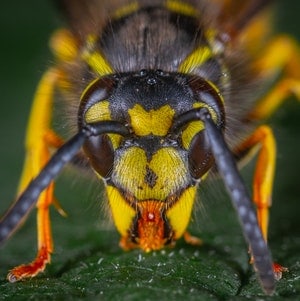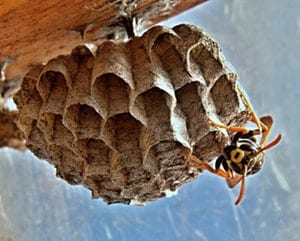Essentially, both wasps and hornets are crucial pollinators. Whether its flowers or plants, these two ensure also that the food chain and growing cycle are unperturbed throughout the year.
So, do wasps and hornets pollinate? Yes. They both pollinate by carrying pollen grains that are stuck into their transparent hairs that cover parts of their bodies.

Table of Contents
How do they pollinate?
Foremost, it is important to note that both wasps and hornets seem like they have almost hairless bodies unlike bees. The outstanding difference between the two is size and color. Wasps are smaller and have yellow and black stripes whereas hornets are larger and have white and black rings.
Both of these insects belong to a scientific group called Aculeata, which refers to their ovipositors modified into stingers. However, unfounded stereotypes regarding visible hair on wasps and hornets are purely unfounded.

These two insects have fine, transparent and dense black hair on the thorax (upper body) and abdomen (lower body) only visible using a hand lens or a high definition camera. They pollinate by carrying pollen grains from one male flower species or plant to a female one. These pollen grains are stuck onto their transparent hairy bodies during the process.
Additionally, they also aid pollination via nectar-sucking of flowers such as the raspberries.
The fact that hornets and wasps are dangerous insects because they sting at will in addition to limited research on their life cycle makes room for false notions in regards to their role in pollination. Although not as efficient as their Vespidae cousins in bees, they are integral in plant and flower pollination too.
Are they as good as bees at pollinating?
Bees are extremely fuzzy for the most part, which makes them well equipped to cart pollen grains across plants or flowers. Although wasps and hornets do have some hair on their bodies, they simply cannot compete with bees as far as pollination is concerned. But, what is it that makes bees such an unrivaled pollinator?
The hair on bees is usually downy and is used to attract pollen grains via static electricity. Unlike bees, hornets and wasps sport spartan crew bodies more suited for their primary work of scavenging and hunting other insects. Wasps and bees perform pollination as an alternative activity whereas bees live and breathe pollination. Sometimes, the aforementioned insects may only be sucking nectar from flowers to feed their squirmy sisters and not necessarily for pollination endeavors.
Common types of wasps pollinators
Fig wasps – they pollinate the flower inside the blossoming fig fruit. The large number of fig trees in the wild can be attributed to this peculiar species.
V-germanica (European wasp) – they pollinate an orchid species called the Epipactis helleborine. This special orchid releases an attractive smell from some chemical concoction that it produces which ultimately lures wasps to its flowers.
Apart from pollinating, what vital role do wasps and hornets perform?
Wasps and hornets are natural predators. Although they are maligned and disliked in the public domain, these creatures are an indispensable part of the ecosystem. They are very aggressive and a bunch of intruders. They sting at the slightest provocation and their arrival only spells danger. However, how are they helpful to ecosystem balance?
The more common yellow jackets species exist in large colonies, probably as large as thousands of them. They are led by their gigantic queen- egg laying mother. They are social insects that utilize their numbers and industry to construct long lasting nests made out of wood fibres and water.
Environmentally, they are useful in controlling the number of caterpillars and greenflies so that they don’t become too many to the detriment of the ecosystem. They prey on fellow insects, especially those that infest crops and garden plants. Ironically speaking, wasps are a kind of natural insecticide. For instance, a small colony of wasps can munch up-to 3000 mosquitos, flies and spiders in a day in addition to killing other insects that harbor and ferry human disease.
Hornets feed their developing larvae with any live insect due to their insatiable appetite. Additionally, wasps take care of dead insects and feed them to their offspring. Furthermore, we wouldn’t want a world filled up with piled residue of dead insects.

Another crucial role, as found by scientists at the University of Florence, is that wasps ferry yeast cells using their guts. Yeast is commonly known to make bread and is a useful ingredient in beer making, although we didn’t know that it resided in wasps! How are these yeast cells helpful? Wasps and hornets feed on grapes which contain a substantial amount of yeast. The collected yeast is kept in the queen’s stomach and hibernates there all through the cold season (winter). When a young generation of wasps is brought about, they are fed the yeast for survival. These offspring then carry the yeast back to the following season’s grapes and effectively improves the yeast content in grapes. Sounds like wasps have got a lot to do with the quality of wine you are enjoying!
What environments and plants suit wasps and hornets as pollinators?
While it is undeniable that bees are super pollinators that account for more than 90% of the flowering that occurs, there are some environments that inhibit their thriving. In such unforgiving circumstances such as the dark forest floor, wasps emerge as the sole pollinators. Additionally, in such dense forests, there are flowers with odd shapes blooming a few centimeters above the ground. Typical pollinators such as butterflies wouldn’t survive in the extremely cold just-above-the-ground plant cover
.
A case in point is the Mitrastemon yamamotoi that grows in the dense forest cover of Japan. This unique plant, according to Professor Kenji Suetsugu of the University of Kobe, depends on an alternative group of pollinators such as wasps. This generally leads to plant diversification. As found out by the Professor after observing the plant’s pollination agents for years, wasps were the main pollinators. They sucked nectar and carried huge amounts of it on their bodies. The recipient yamamotoi flowers visited by these wasps were said to successfully come to fruition. Furthermore, it is crucial to note that the yamamotoi plant thrives in very dark habitat that makes it virtually impossible for typical pollinators to visit that giving wasps and other uncommon pollinators such as cockroaches the edge. The predatory instincts of wasps makes the insect look for food in very gloomy environments for adaptability purposes.
Does a wasps craving for sugary content crucial to their role in pollination?
As much as wasps and hornets are an omnivorous species, they have a sweet tooth. The adult species love nectar found in flowers. They suck the nectar until satiation and may carry some pollen grains along with them which they inadvertently drop on other flowers’ stigma thus aiding pollination. Their high affinity for sugar makes it possible for such.
What about pollinator-dependent crops and the diminishing natural habitat?
In recent years, a lot of pollinator-dependent crops have substantially increased. The need for diverse foods and fibre coupled with the downward trajectory of bee numbers have paved way for other pollinators to take charge. A study by Romina Rader from the University of New England in Armidale dug up the potential for non-bee insects in plant diversity using 17 distinct crop species that spanned 5 continents. As aforementioned, non-bee insects were found to be far ineffective pollinators but they visited flowers more often than bees did thus making up for their ineffectiveness.
Crucially, a measure of pollination success was conducted to cement this finding. It is referred to as seed set or fruit set- when a young fruit starts to grow quickly after ovary fertilization. Seed set was found to increase with non-bee insects such as wasps. Ubiquitously, the finding suggested that non-bee insects were capable substitutes for bee visitations. Furthermore, non-bee insects are more adaptive and aren’t affected by the loss of their natural setting or habitat unlike bees which are overly dependent on their environment for nesting and support of host flowers or plants.
Do wasps’ deserve more public acclaim for their role in pollination and ecosystem balance?
From over 908 research documents about pollinators dating to over 20 years ago, only 2.4% of them focused on hornets and/or wasps. That is not only a staggering statistic, but also a key pointer to how scientists have failed in diminishing the bad public image associated with these insects.
As much as hornets and wasps are important pollinators, their role in the overall ecosystem balance cannot be overlooked whatsoever. Climate change has drastically reduced the numbers of these species and the marginal scientific interest in them has only intensified the already worsened situation. Bees are agreeably better pollinators but they have a far less ecological impact as wasps do. There needs to be a strategic and well-founded scientific movement that will work consistently and impartially to discard the tainted image of the wasps and hornets.
Conclusion
Wasps and hornets are an indispensable part of the ecosystem and their importance is far-reaching. With the ever-changing climate patterns and the receding number of bees, focus ought to be directed at these insects as potential and able substitute pollinators. They are not only a hardworking species, they are also very adaptive to habitat change and plant needs to suit their feeding and survival needs. Dedicated insects yet underappreciated, they seamlessly ensure perfect balance of the ecological system. With a wider sensitization campaign and more scientific input, their value will only grow by the day.

Hey! Someone in my Facebook group shared this website with us so I came to give it a look. I’m definitely enjoying the information. I’m bookmarking and will be tweeting this to my followers! Exceptional blog and fantastic design and style.